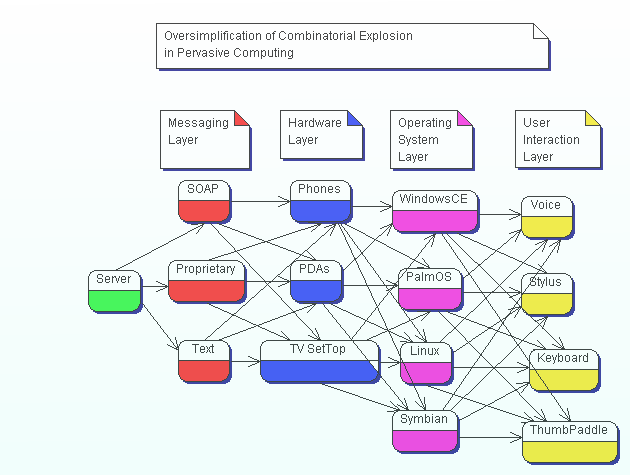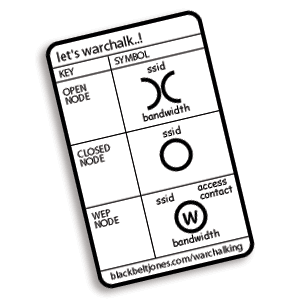Last Updated: February 13, 2004 09:15PM
"... but of course that was the thing about information. Without it, a person suffered enormous complications." A Spell for Chameleon , by Piers Anthony
View this page as series of slides through the magic of xslt.
- Goals for Session:
- Understand what is meant by "Pervasive Computing"
- What human problem does it solve
- Know what is meant by fancy-schmancy terms like WLAN, Wi-Fi and BlueTooth
- Explore the wonderful possibilities of the future world of Pervasive Computing
- Feel the power of the Dark Side of Pervasive Computing
- Know the big underlying problems with the technology and business aspects
- Comprehend the coming storm
- Get out of here in under 50 minutes
- My favorite references:
- What is Pervasive Computing?
Imagine a world filled with all sorts of gabby electronic devices - traditional desktop computers, wireless laptops, small PDA ipaqs, smart cell phones, tiny wristwatch pagers, clever little coffee pots. Imagine all these devices talking easily to one another to bring you the news you need when you need it, regardless of where you are. You have just imagined the future of Pervasive Computing (PvC).
- Big human problem:
"... but of course that was the thing about information. Without it, a person suffered enormous complications."
A Spell for Chameleon , by Piers Anthony

"I need my information right here, right now."
- First, some definitions:
- WLAN
Wireless Local Area Network
- PAN
Wireless Personal Area Network
- IEEE 802.11a
Wireless protocol designed to replace LAN wire connections; 56MegaBit ; expensive; not widely deployed; 5 Ghz unlicensed spectrum (issues with the military)
- Wi-Fi IEEE 802.11b
Wireless protocol designed to replace LAN wire connections; 300-1000 ft range; 2MegaBit-11MegBit ; $90 ; High power requirements; 2.4 Ghz unlicensed spectrum used along with telephones and garage door openers
- IEEE 802.11g
Wireless protocol designed to replace LAN wire connections; 56MegaBit 2.4 Ghz unlicensed spectrum, just now being deployed; backwardly compatible with 802.11b
- Hotspots
Where to join into a wireless network in Austin. (One friend pays for Starbucks, the rest freeload).
- WarChalking
- BlueTooth
Wireless protocol designed to replace short cables; 30 ft range; 1.2 MegaBit; $10; Low power requirements; 2.4 Ghz unlicensed spectrum;

- 3G
The future of fast, smart telephones
- UWB
Ultra-WideBand - future (2003) rival to Wi-Fi and BlueTooth; 100Megabits; lower power than BlueTooth
- SMS
Short Message Service - "texting" over phones

- Voice Application Software:
Software to understand and create speech - Live operators cost between $5 and $20 per customer call. Voice Application software can do it for between $0.20 - $1.
- VoiceXML (1999, AT & T, IBM, Lucent, Motorola)
- Speech Application Language Tags or SALT (2001, Microsoft, Cisco Systems, Comverse, Intel Corp.)
- WLAN
- Some Business Uses of Pervasive Computing:
- Healthcare:
- records, lab order entry and results reporting (MRIs on the patient's TV)
- prescription writing (mistakes, loss of paper copy, forgeries)
- medications (what if every pill had a UPC code on it?)
- billing and costs (why do I have to file my records?)
- personnel scheduling
- Mall interviewing with semi-connected TabletPCs
- Vending: improved routing, resupply, ordering; price changes pushed to machines
- Service Industry: "Cable guy will be at your home between 8am and noon." / GPS
- Distribution: "Where is my package?"
- MicroPayments: with cell phone for vending, train tickets, ...
- Micro/Nano devices Hitachi's Mu Chip 0.4mm square, 128 bit ROM, Interrogated at 2.45GHz, useful for documents, currency, shopping, preventing "shrinkage"
- Military: Operation Anaconda
- Others?
- Healthcare:
- Some Personal Uses of Pervasive Computing:
- Personal Information: PDA with wireless connections to web, broker, child's school, appointments, telephone numbers
- Flight Schedules: Your phone rings. Its the computer at American Airlines. Your flight departure is delayed by 20 minutes.
- Networked coffee shop: Wi-Fi at StarBuck's and Schlosky's
- Location: finding friends at the mall (or hiding from), texting
- Home interaction: The networked coffee pot/an alarm clock sync'd with Outlook / Electricity Peak Conservation/Thermostat/Hot Water Heater connected via wireless network (security issues)
- Car: schedule oil change seamlessly w/ garage; maps; traffic; kid movies streamed to back seat ("Only if its quiet back there")
- Finding Possessions: "Dude, where's my dog?"
- Others?
- Security Issues
The whole PvC arena is rife with security concerns.
- Theft of Wi-Fi services,
- Theft of email and server files
- Identity theft
- Denial of Service (DoS) Attacks
- Secure Payments
- The compromised coffee pot
- Big technical problem:
How to write a single application that will deploy and run on all client devices navigating combinations of the following in a data transaction:
Layer Option 1 Option 2 Option 3 Option 4 ... 1. Server .Net WebSphere WebLogics Other J2EE 2. Secure Server Data
(Optional)Passport/Palladium Liberty Alliance 3. Security
(Optional)HTTPS Proprietary HTTP (none) 4. Connectivity Mode/Speed Constant Intermittent Cradle 5. Technical Connectivity LAN Wi-Fi (802.11b) Cellular 3G 6. Business Connectivity Roadrunner Boingo Wireless AirMagnet Cometa 7. Messaging SOAP REST text proprietary 8. Client Operating System PocketPC PalmOS Linux Symbian 9. Client Framework Software .Net Java Virtual Machine (JVM) Generic Web Server Colligo 10. Client Application Software Mail Readers Browsers Contact Info Games 11. Hardware Devices plain/cell/smart phones tv settop boxes PDAs/Wristwatch cars, home appliances 12. Entering information Keyboard/Keypad/Thumb paddle mouse stylus voice 13. Receiving information text graphics audio (What's with those ugly colors?)
- Combinatorial Explosion of Possibilities:

- Big business problem:
How to provide the connectivity to wireless customers at a price the consumers will buy and the business can make a profit.
Example: Sky Dayton's Boingo: $75/month for "nationwide" service / $895 do-it-yourself kit for retail owners who get $1 for each login.

Example: Long Beach California is providing Wireless free as a community service. Long Beach found that after setting up the partnerships it could offer the service for a cost to the city of about $3,000 per year. "The extra business if nothing else is certainly going to offset that," said Bruce Mayes, a city economic development official who is project manager for the wireless zone.
- Misc Issues / Thoughts
- How to know "what" to push to which device? Graphics to slow speed IPAQ? What is cost of network?
- Dartmouth 500 Wi-Fi wireless access points / "Nobody here knows anyone's phone number."
- Passport / Palladium
- Apple's iSync software
- Groove Edge Server
- Views of the future:
- Microsoft's View of the world:
.Net everywhere, XP embedded edition using 'Compact .NET Framework' (PocketPC API is passe) on the client and .NET on the server. Smart Personal Objects Technology (SPOT) will be used on .Net-enabled keychains, alarm clocks and other tiny devices.
- IBM/Sun's View of the world:
Java Micro Edition (J2ME), Personal Java (PJ), or Java Standard Edition (J2SE) on the client and WebSphere on the server
Which framework is the easiest to create content and which framework is the most prevelant on the user's hardware?
- Microsoft's View of the world:
- Review:
- What is meant by "Pervasive Computing"?
- What human problem does it solve?
- What is meant by WLAN, Wi-Fi and BlueTooth?
- What are some possibilities of the future world of PvC?
- What are some of the dark sides of PvC?
- What are the big underlying problems with the technology and business?
- Conclusion:
We stand at the beginning of yet another epoc in computers. The battle lines are drawn for the heart and soul of this new infrastructure. Let the games begin.

